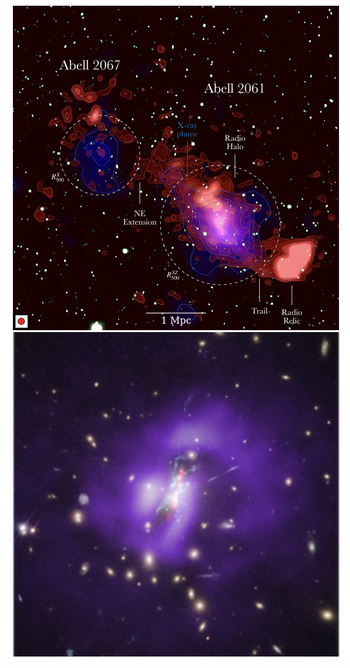
Top: radio emission in between clusters A2061 e A2067 (Credits: Pignataro et al. 2024). Bottom: the Phoenix cluster of galaxies observed in X-rays (Chandra), radio (VLA) and optical frequencies (HST). Credits: NASA/STScI
Galaxy clusters and the cosmic web contain"non-thermal" energy, i.e. in the form of magnetic fields, relativistic particles and kinetic energy of turbulent or regular motions of the plasma.
Radio observations show a variety of structures: "halos", "relics", "mini-halos" e "mega-halos" , all fundamental to understand the mechanisms of acceleration of relativistic particles.
More peripheral structures, such as "bridges" between galaxy clusters, are fundamental to the study of the plasma before its accretion. Recent observations have also revealed magnetic field in filaments of galaxies, which may clarify the origin of the magnetic field in the Universe.
The mechanical feedback from AGN modifies the gas thermodynamics, balancing the effect of X-ray energy radiation, mixing the gas in the densest regions and transporting relativistic particles and magnetic fields over the cluster.
We study and observe the evolution of cosmic structures and of their magnetic field, combining advanced cosmological simulations (produced for example at CINECA ) with observations from radio (for example with JVLA, LOFAR, uGMRT, MeerKAT, ASKAP), to microwaves (for example with ALMA) up to the highest frequencies (in X-rays with Chandra, XMM and XRISM), also in preparation for the advent of the Square Kilometre Array (SKA), the largest telescope ever built by humanity.
